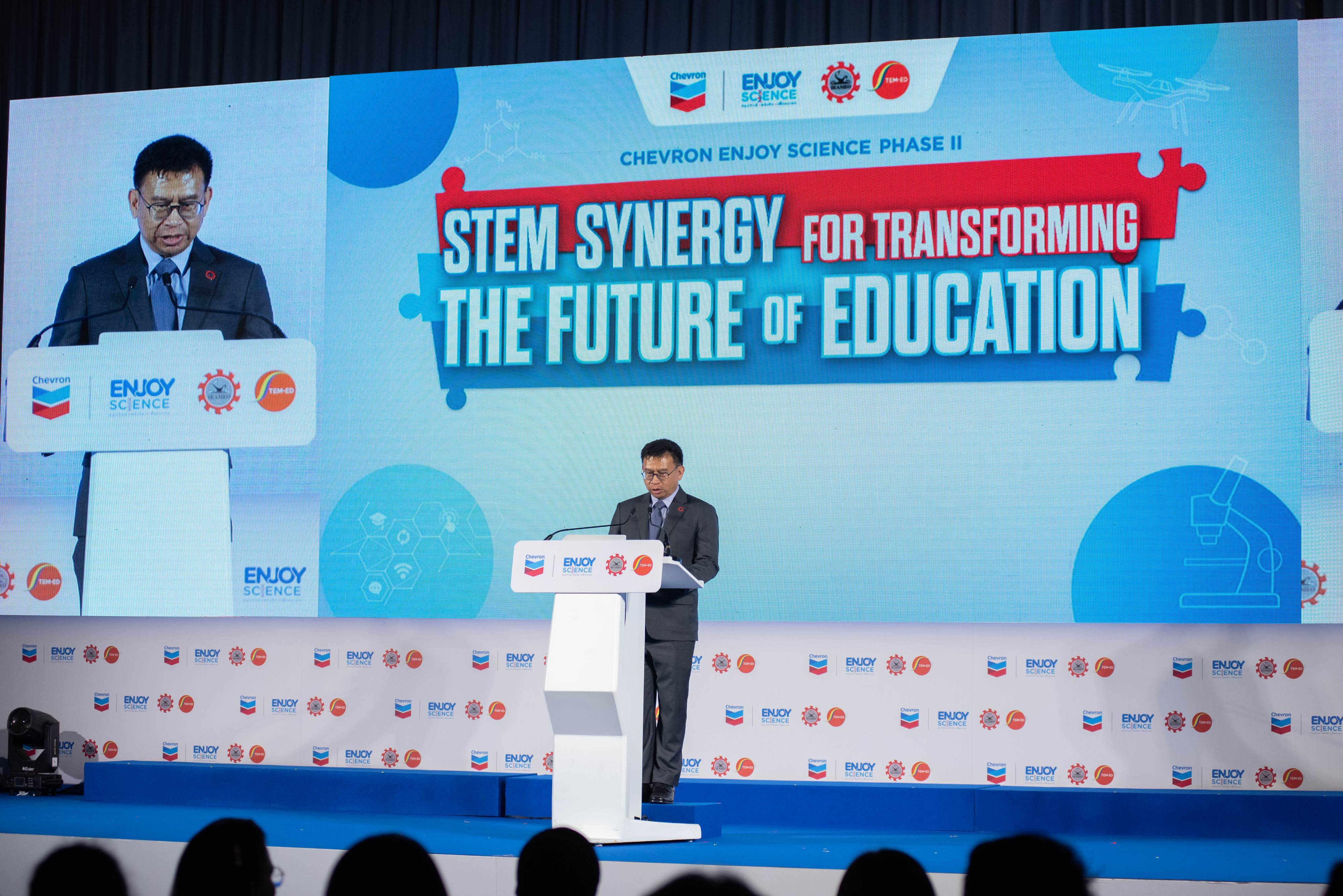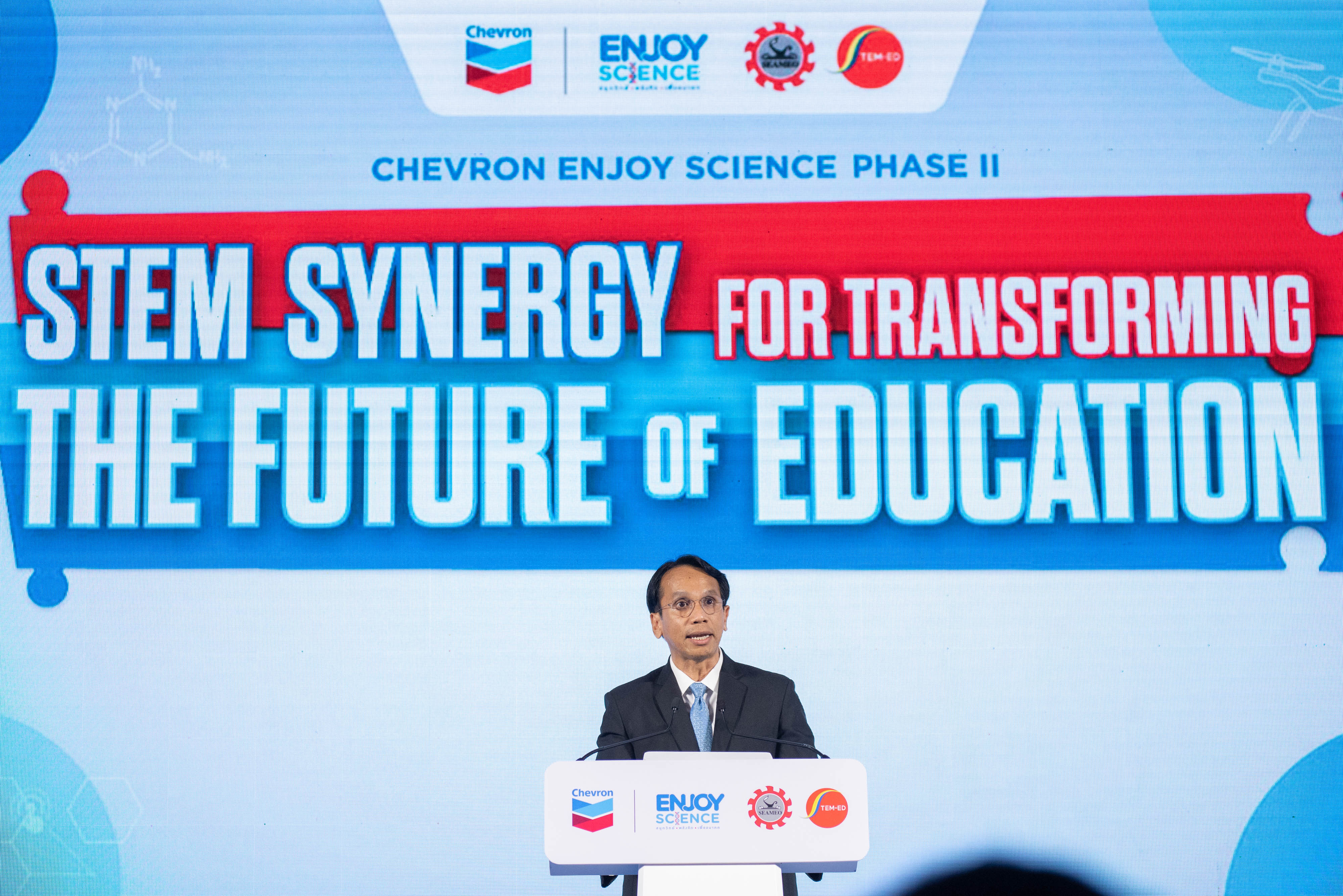feature Unveiling Chevron Enjoy Science’s success: Cultivating enjoyable STEM education for a nation’s future

“When it comes to STEM education, many people may think that it is a science that is limited only to science students. Over the past 8 years, Chevron Enjoy Science project has been cultivating a new mindset and establishing connections to make comprehensive STEM education accessible to everyone, regardless of their professions or studies, whether it be science or art. The project aims to arm individuals at all levels with the 21st century skills, leaving no one behind. Today, as the 8-year project reaches its conclusion, it has helped establish a fundamental point for sustainable adoption of these principles into nationwide and regional models.” The remark by Dr. Kritsachai Somsaman, Director of SEAMEO STEM-ED at the STEM Synergy for Transforming the Future of Education conference, marked the next phase of STEM education promotion efforts through collaborations among the public, education, and private sectors.
“When it comes to STEM education, many people may think that it is a science that is limited only to science students. Over the past 8 years, Chevron Enjoy Science project has been cultivating a new mindset and establishing connections to make comprehensive STEM education accessible to everyone, regardless of their professions or studies, whether it be science or art. The project aims to arm individuals at all levels with the 21st century skills, leaving no one behind. Today, as the 8-year project reaches its conclusion, it has helped establish a fundamental point for sustainable adoption of these principles into nationwide and regional models.”

Dr. Kritsachai Somsaman, Director of SEAMEO STEM-ED
The remark by Dr. Kritsachai Somsaman, Director of SEAMEO STEM-ED at the STEM Synergy for Transforming the Future of Education conference, marked the next phase of STEM education promotion efforts through collaborations among the public, education, and private sectors. The event aimed at sharing ideas and success cases from the Chevron Enjoy Science project phase 2, driven by The Southeast Asian Ministers of Education Organization Regional Centre for STEM Education (SEAMEO STEM-ED) and Chevron Thailand Exploration and Production, Ltd. One of the challenges that the project focused on was “How do we make STEM education accessible to everyone?” The project not only focuses on students but also thrives on cooperation from all sectors. By fostering collaboration, the Chevron Enjoy Science project has made a difference by developing the project in a multidimensional manner, creating interconnected links between organizations that progress together. This collaboration spans from students and teachers to policymakers, inspiring and driving tangible results verified by researches from various independent research organizations.
"The project didn’t only prioritize short-term success during its operation. We emphasized promoting evidence-based study method with its proven success to serve as a guide for policy advocacy and the development of suitable learning strategies for countries in the Southeast Asian region. Over the past 8 years, 724 schools have participated in the project, benefiting over 3 million individuals through the collaboration of a network of 152 partner organizations. The project has been able to create awareness of STEM education, reaching over 163,635 individuals. It has also addressed diverse dimensions of STEM education. For example, initiatives like the STEM Professional Academy, focusing on teacher and educational leadership development, have contributed to a network of over 6,500 personnel. The STEM Career Academies has inspired and created career pathways for more than 4,000 youth. This includes new educational development projects, such as the use of visual teaching materials like the Picture Books.” Dr. Kritsachai Somsaman added.
Although student development is the project’s key objective, the development of education personnel through initiatives like STEM Professional Academy, remains important. It has built “Master Teachers” who establish professional learning communities (PLCs) that serves as another mechanism to efficiently extend the project's impact to students.
Asst. Prof. Dr. Amonwan Weerathammo, Secretary-General of the Teachers Council, states, “Teachers play a crucial role in creating a creative learning environment in the classroom, acting as messengers who hold the key to unlocking creativity. The Professional Learning Communities (PLCs) have driven an overall movement in the form of a sandbox, to enhance the effectiveness of the learning process for both students and teachers. The project has strengthened the capacity of teaching management to more than 5,000 teachers, with a cumulative finding that more than 96% of the teachers can utilize questioning strategies during teaching. This empowers students to express themselves, engage in discussions, and cultivate a new culture in the classroom. This has also created a robust culture that allows teachers to continuously develop themselves. Today, the Professional Learning Communities (PLCs) have become a vital process embedded in the curriculum that teachers must implement, fostering policy-driven changes in teacher and administrative evaluation. This evolution has led to an openness among teachers in various areas, embracing and adapting teaching methods in alignment with these principles."
In terms of inspiring and broadening horizons for youth to explore diverse career paths, The STEM Career Academies is another project that focuses on developing vocational skills in the field of STEM through real work experiences. This is achieved through a training program comprising 14 courses. For example, the project collaborated with partners to develop 6 short-term courses to prepare youth for careers in the healthcare sector. Additionally, the project collaborateed with the Office of the Basic Education Commissionto to drive a pioneering initiative for smart agriculture careers, partnering with 6 schools in the northern region and planning to expand the project to an additional 340 schools nationwide. The project has shown a success rate of over 33%, where participants have received job offers, and the remaining 67% have chosen to pursue further education in their areas of interest. Moreover, it provides an opportunity for youth to explore the expanding career paths in the STEM education field. The project also has plans to collaborate with international partners for research exchange and further scholarship opportunities for vocational training.
“STEM careers are evolving. Therefore, it is necessary to promote STEM skills for all students, including non-STEM students, to enable them to integrate these skills into various professions. What we need to do is to create an educational environment that inspires children in STEM education from the beginning. In my perspective, the STEM Career Academies project will be a significant model to develop skilled workforce aligned with the demands and propel regional competitiveness to a new level," said Asst. Prof. Dr. Rawin Raviwong, President of National Science Museum (NSM).
As reading and interpretation form the foundation of learning, it is essential to train teachers and develop students, which serves as both the source and culmination. Developing 'mediation' is also an important tool in creating fun and inspiring STEM learning experiences. The Picture Books is another project that adds the 'fun of learning,' providing primary school students with opportunities to develop analytical and creative thinking skills through the use of visual books.
"A challenge we often encounter is that some students can read but they struggle to comprehend or interpret the content. Hence, we initiated the Picture Books project, utilizing picture books as a tool to develop critical thinking skills for students. Through the guidance of teachers who create a safe learning environment by posing open-ended questions, children are encouraged to think freely. As a result, we find that children learn to read joyfully and engage in reading to seek meaning, which forms a crucial foundation that can be extended to other aspects of their daily lives. This year, the project has planned to create a teaching guide using picture books, aiming to disseminate it for students to use and for teacher training to further expand the project's impact," said Dr. Rungrong Sommitr, Head of Research Project from the Faculty of Education, Srinakharinwirot University.
Chevron, a global energy company that believes in the “Human Energy,” doesn’t only aim for the numbers, but also for the long-term viability and the big picture of the project, including building a workforce rich in STEM education skills and expanding networks far and wide.

Pativate Boonyapaluk, Vice President of Chevron Thailand
Pativate Boonyapaluk, Vice President of Chevron Thailand, states, “At the STEM Synergy for Transforming the Future of Education conference, I witnessed a new beginning for STEM education, stemming from the results achieved over the 8 years of collaboration between Chevron and our partners. Today marks another success where we see the public sector, private sector, and educational agencies across Thailand and the region joining to listen to the journey and success of the project. This project is seen as a model that the education sector can use to further develop and promote various policies in the future.”
The culmination and the fundamentals laid by the project throughout the 8 years has paved the way for a fresh start. Numerous organizations have adopted the education models from the project. For example, the Teachers Council and Office of National Higher Education Science Research and Innovation Policy Council (NXPO), has brought the successful model to unlock and elevate the development of new-gen vocational teachers. Some private sector organizations both domestically and internationally are replicating the STEM Career Academies. Additionally, The Ministry of Education has also used the classroom research format by recording teaching videos for teacher assessments. It is evident that the success of the project today marks the transition to the next level of STEM education development at the regional level, contributing to sustainable global progress in the future. Those interested can find more details about the project at www.chevronenjoyscience.com/th.